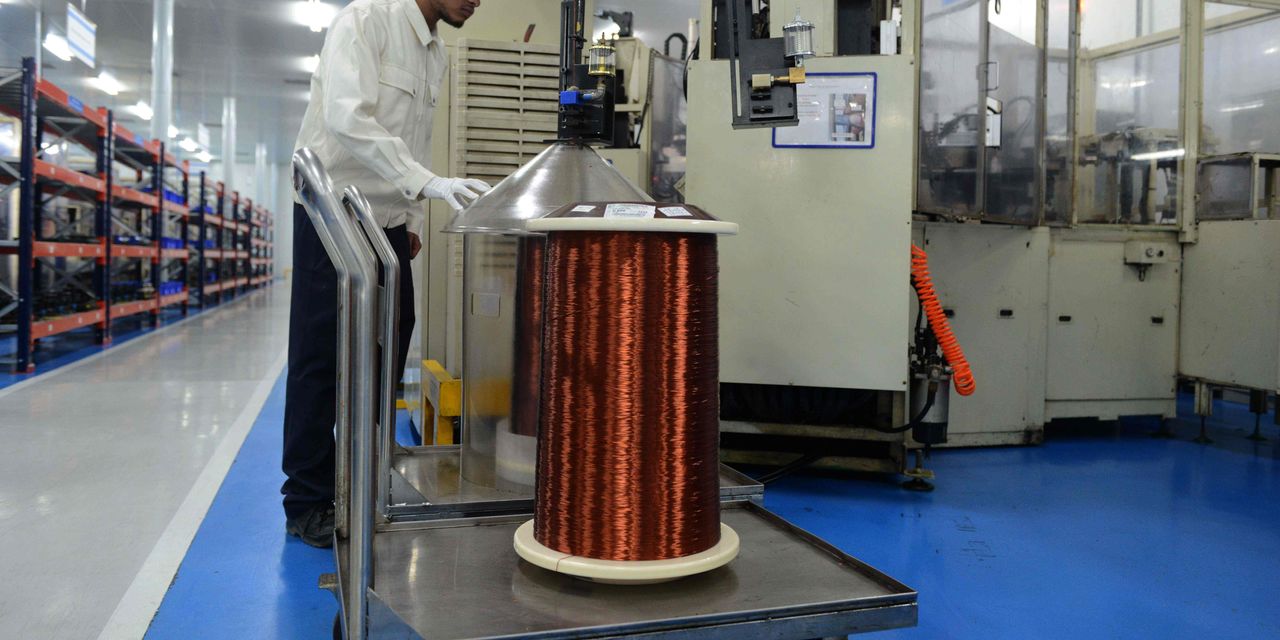Copper’s performance has been less than stellar this year, with prices of the industrial metal for the second quarter on track to register their largest quarterly percentage loss in a year.
Copper’s nickname of “Dr. Copper” is fitting, given its performance is, in general, a “sign of the global economic situation,” said Kevin Murphy, director of research, metals and mining, at S&P Global Commodity Insights.
At the moment, copper is offering a pessimistic view on the global economy, having dropped to its lowest price in six months just over a week ago.
Futures prices for copper on Comex
HG00,
HGN23,
traded as low as $3.545 a pound on May 24, the lowest intraday level since Nov. 28, according to Dow Jones Market Data.
As of Wednesday, prices for the most-active futures contract trade down by 4.6% year to date and were poised to lose 11.2% in the second quarter, which would be the worst quarterly performance since the second quarter of last year.
“With global GDP growth being constrained again this year, and all signs pointing to Chinese demand being far less than hoped after the end of COVID lockdowns, copper demand has been coming in less than expected,” said Murphy.
That, combined with some reasonably large mines that have been commissioned over the past couple of years, has pushed the copper market into a supply surplus, he said.
In the first quarter of this year, preliminary data indicates that world copper mine production rose by about 2.2% and world refined copper production climbed by around 7.5%, according to a report from the International Copper Study Group. The report also showed that a preliminary rise of roughly 2.3% in global apparent refined copper usage.
Overall, the preliminary world refined copper balance in the first quarter indicates an apparent surplus of about 332,000 metric tons, “based on Chinese apparent usage,” the ICSG said. That compares to a supply deficit of 428,000 metric tons in 2022.
Anxiety around the state of the Chinese and global economy have led to price declines in the industrial metals complex, including copper, said John Caruso, senior market strategist at RJO Futures, told MarketWatch.
China’s official manufacturing purchasing managers’ index, the official gauge of the nation’s manufacturing activity, fell deeper into contraction in May, down to 48.8, from 49.2 in April, the National Bureau of Statistics said on Wednesday. The result was below the 49.7 expected by economists surveyed by The Wall Street Journal.
Caruso said he doesn’t expect a quick recovery in copper prices in the near term, given that there’s “too much evidence” that points to a slowdown of the U.S. and Chinese economies over the next two to three quarters.
Copper managed to “catch a bid” following the release of China’s private gauge of factory activity, he said. The China Caixin manufacturing purchasing managers index rose to 50.9 in May from 49.5 in April, according to data released Thursday by Caixin Media and S&P Global.
Copper futures settled Thursday with a gain of 2% at $3.71 a pound.
Still, “one data point does not suggest a trend,” said Caruso. U.S. manufacturing also remains in contraction as well, Caruso said.
The U.S. Institute for Supply Management’s manufacturing survey slipped to 46.9% in May from 47.1%, data released Thursday showed. The key barometer of the nation’s factory activity was negative for the seventh month in a row.
Still, there are signs that demand for copper is poised to see significant long-term growth, along with an eventual supply shortage.
“Copper supply side issues coupled with the expected burgeoning demand from the [electric vehicle] space are the key data imbalances all analysts are watching,” Caruso said.
Read: Here’s what the U.S. plan for EV sales means for critical metals such as copper and lithium
“Forecasts suggest “growing demand for copper from the power and construction sectors, and the proliferation of electric vehicles may result in a copper shortage by 2025.” ”
Stuart Katz, chief investment officer, at wealth management firm Robertson Stephens, said forecasts suggest “growing demand for copper from the power and construction sectors, and the proliferation of electric vehicles may result in a copper shortage by 2025.”
Copper prices are expected to rise in the coming years, with some predicting record levels due to a deficit in copper supply and robust demand, Katz said.
For now, however, copper remains in a bearish trend,” said Caruso. “The cognitive dissonance here is understanding the longer-term bullish fundamentals of the market, but also respecting price and market flow.”
Caruso said he remains “interested in the long side of copper and will continue to “map out the broader economic cycle for hints of a turnaround,” but hasn’t seen any hints yet.
There “could be more downside to come over the intermediate-term,” he said.
Read the full article here












